Now that winter has dumped several feet of snow on a garden that was almost snow-free, I’m back by the fire, metaphorically at least, dreaming of the seasons ahead.
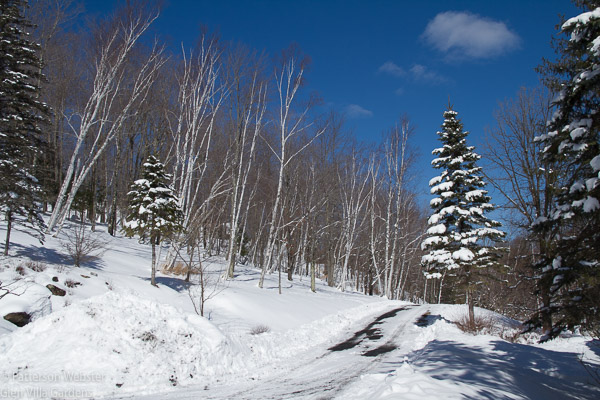
I took this photo about ten days ago after a fresh snowfall. Today is grey. And maybe more snow will fall. I hope not.
I’m dreaming about a trail that will lead around the property. I’m considering the route it will follow and what I will call it. I know the purpose of the trail — it will connect art installations now in place and others I’m working on, or planning. And while there are problems about the route, the big question is what the trail should be called.
The choice of a name may seem inconsequential but in my mind it matters enormously. A name does more than describe, it defines significance, and finding the right name is proving more difficult than I anticipated. The name I’m searching for will encapsulate what links the different installations and how they add to the experience of walking the land. It will identify something meaningful.
The trail as it now exists starts in the Upper Field beside the Skating Pond and leads into the woods.
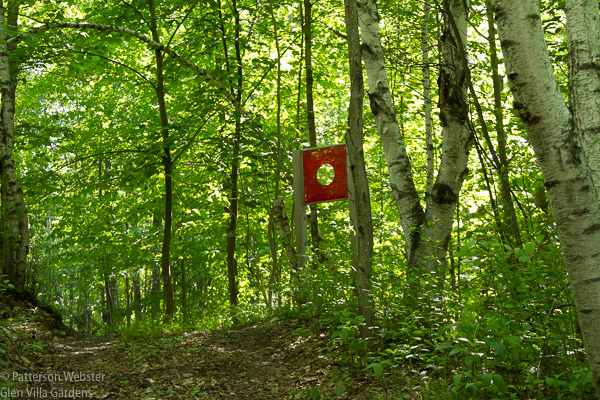
In Transit/En Route is a path lined with signs that ask questions about time, space and our relationship to them.
The end point of this installation, called In Transit/En Route, is a clearing, where a bench offers a place to sit and reflect. (I’ve written more about In Transit/En Route here, here and here.)
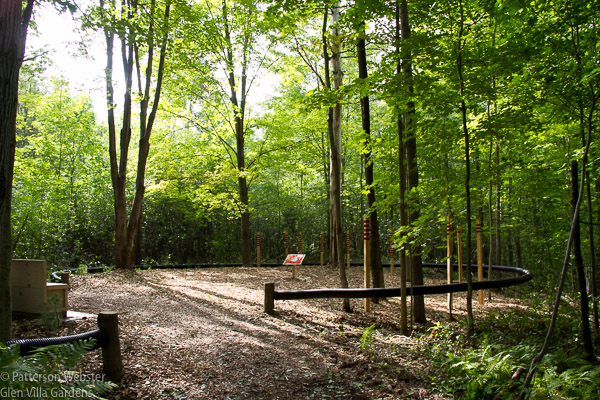
This is the Sundial Clearing. On the left is an uncomfortable pine box that serves as a bench. The shadow of a dead pine tree marks the hours of the day as it hits upright posts placed around the circle.
The trail continues beyond the sundial clearing into a meadow-like area with a small stream.
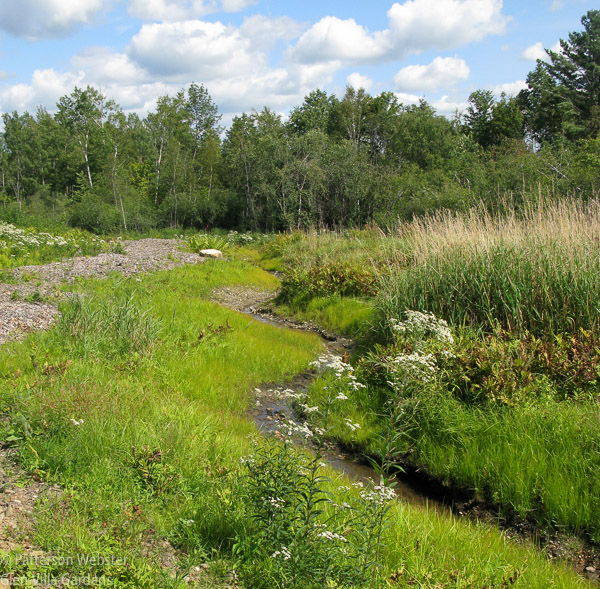
You can see a bit of the trail on the left side of this photo, taken in 2009. Last fall we cleared the brush that was smothering the wildflowers. I’m betting that now they will return.
Currently there is no installation in this space, tentatively named the water meadow. I plan to create something for the site but I don’t know what, although Heraclitus comes to mind. Over the summer I’ll spend time in the area, giving it a chance to speak — and giving myself time to hear it.
Beyond the water meadow, the path splits and splits again. At the second division, a tall tree trunk painted yellow announces Two Roads.
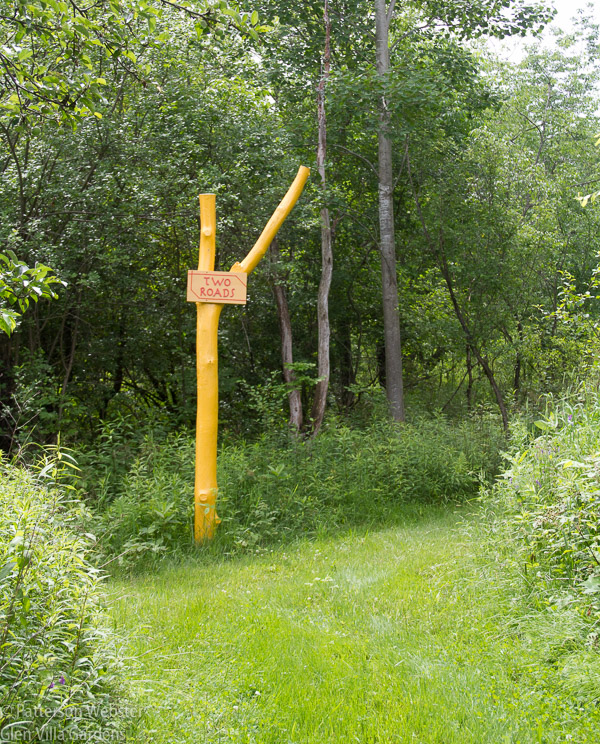
I learned only recently that the ‘yellow wood’ Frost refers to is not the yellow of New England’s autumn foliage but a wood full of yellow daffodils. I’m still trying to get my head around this change of season.
As in the poem, the two roads that present a choice to the walker lead to much the same place. At that spot, years ago, there was a farmhouse and a barn. Now it’s a quiet spot, out of the way, with a glade that reminds me of a poem by Yeats. In a year or two I will make an installation for the site, and possibly Yeats’ poem will be the genesis. But my idea needs time to grow and ripen, like the nine rows of beans he dreams of planting.
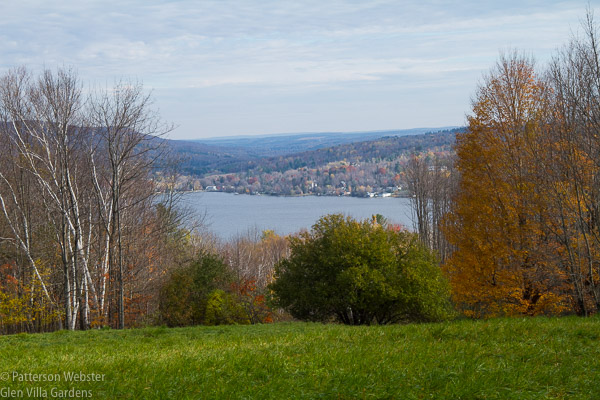
From the farmhouse there used to be a wide view onto the lake. We are restoring the view gradually.
Beyond this site the route becomes complicated. There are simply too many ways to go, and too many sites that call out for recognition. The marks that history has left on the land often dictate where an installation needs to be placed and these land marks are not arranged neatly in a loop. Sometimes they veer off abruptly. Sometimes they are too close together, or too far apart. And sometimes the rhythm of the walk dictates the need for an installation even if there are no historical marks or striking natural features. That is the case in the fields near Lilac Cottage, a small house surrounded by lilac bushes, that many decades ago was used by a tenant farmer.
On two sides of the cottage are farm fields, and I’m working now on installations for both. Crossing one field will be a simple avenue of crabapple trees that I hope to plant in early spring. Crossing the other will be a more complex installation, inspired Ian Hamilton Finlay’s Scottish garden, Little Sparta, and tentatively titled The Past Looms Large.
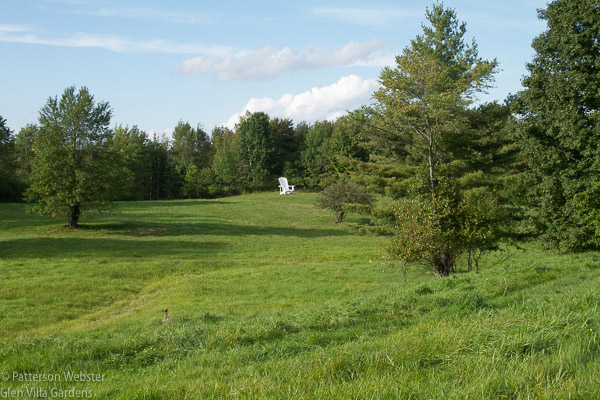
The installation I’m working on now will lead across this field towards the Big Chair. I hope to complete the project by May, so stayed tuned.
Logic dictates that the path continue beyond the Big Chair, from the sun-filled field into a rather gloomy forest. The transition from light to shade is abrupt and is matched by a change in topography. From a dry, relatively flat field, the path leads downward, becoming increasingly soggy, provoking a change in mood that I hope to make explicit. (Dante, anyone?)
Following this same path, walkers reach Orin’s Sugarbush, a project that needs only a few finishing touches before it is complete. (For more about this installation, click here and here.)
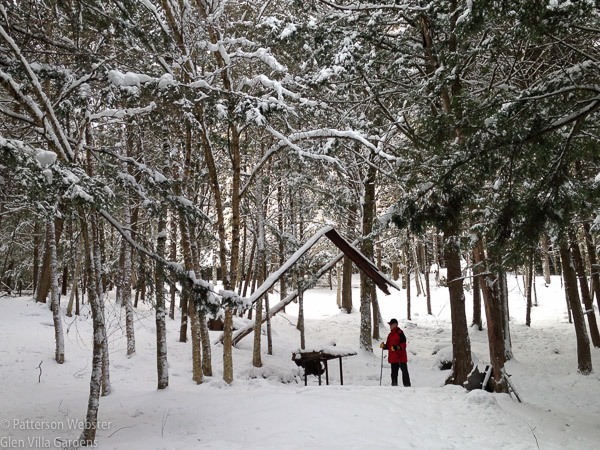
On a snowy day in January, my husband and i snowshoed past Orin’s Sugarbush. It is magical in winter, when the tin maple leaves suspended from the trees chime in the wind.
A short distance beyond Orin’s Sugarbush the path comes out into another field. Here, walkers cross a stream before heading up the hill to the Skating Pond where they began.
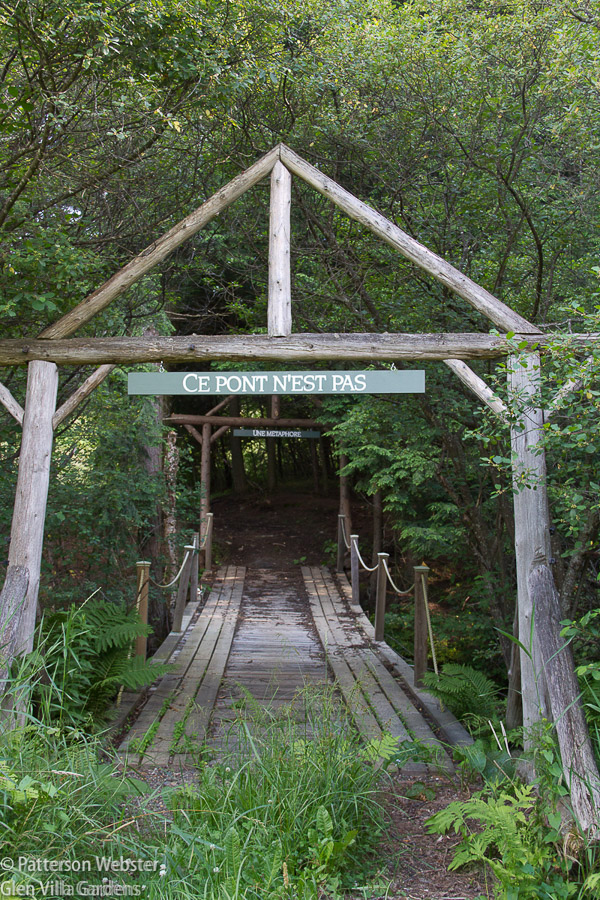
My son calls this the metaphoric bridge. In one direction the words are written in French, in the other, in English. And despite what the signs say, the bridge is actual.
Walking the trail I’ve sketched out would take a fast walker an hour at least. Loops off the main trail could easily add another hour or more. And loops seem necessary: at almost every junction another site calls out to be honoured.
These site specific installations speak to what was, but also to what may be. It is easy to walk across the land and see nothing, or to see only a tiny part of what is there. It’s easy to miss the spirit of the place. My hope is that the art I create makes this more difficult. That it helps us to see.
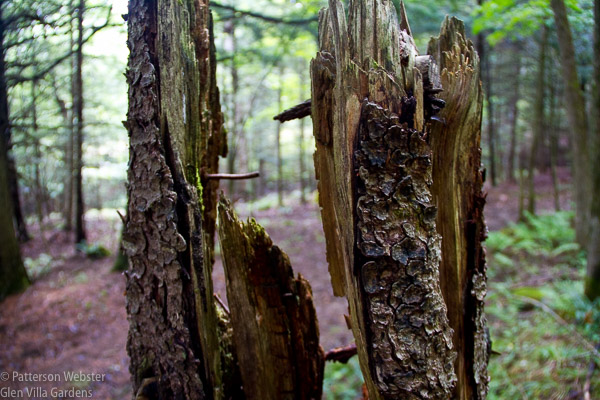
I’ve been watching this tree rot for half a dozen years or more. Each time I pass it, I stop and notice what has changed.
Which bring me back to what this trail will be called. I’m searching for a name that brings to the surface the ideas that link the installations. Regular readers will know that I like using words outdoors. (I wrote about this recently on the English website ThinkinGardens. You can read that here.) Words are a part of the installations I’ve created to date and that will probably continue. The passage of time and the history of the site are elements as well, yet I know there is something more, something deeper that I haven’t identified.
I want a name that rolls off the tongue easily, that isn’t pretentious. Most important, though, it needs to encapsulate what the trail as a whole reveals about the land and the experience of being on it. It needs to speak to the deep heart’s core.
Do you have suggestions? I welcome individual words or combinations of words — even crazy thoughts. Because who knows where a thought will lead?






I love paths. I have been making trails through our acreage, but it never crossed my mind to name the path(s). I do name areas; you almost have to if you’re going to talk to anyone else about them. No art installations, but a hammock, a swing, and some benches are all destination. In some places I’ve just made the deer trails a little more passable for humans and they don’t really have a “reason” for them yet. I will think about names for your path. The only thing that came immediately to mind was The Way, which sounds pretty pretentious to me.
I agree, Kathy, naming areas makes it easy to talk to other people and know you are both thinking of the same place. I’m glad you suggested The Way. Using ‘way’ as part of the name has been near the front of my mind for a few weeks now. I like the double sense of the word. I don’t find The Way pretentious. Without a modifier, it may be a bit too prescriptive for me. Still I like it.
I’m resisting saying ‘Way to go’ – then couldn’t resist! Xxx
Never resist. This makes me laugh so much that I may end up using it.
You could be right – made me laugh too. I like the combination of the utterly banal as an instruction, and the appreciation of your efforts. Not bad!
Villa Way! I wish we would get more sun here; the magnolia’s are starting!
I thought of calling it Glen Villa Way but it sounds too flat to me.
Yes- no!
I’d love to give you a name and that way inveigle my way into your garden, and I will let the question sit in my mind. But the best inspirations for me (and I’m sure for you?) have come suddenly and unexpectedly out of the inner recesses of my psyche after much painful and unproductive thought. A drink sometimes helps… Xxxxx
Inspiration comes in a flash. A drink helps almost everything, especially at the end of a long day. As long as it is red and contains fermented grapes.
You got it…. Xxxx
Spectacular post–spectacular path–spectacular trail–always new discoveries.
Thank you! Compliments are always welcomed.
Goodness, this is a hard one. I often have my clearest and most creative thoughts when I’m driving a long distance (an hour or more). There’s something about doing a simple task that occupies one part of the brain that makes room for complicated ideas to untangle in another. I think it’s notable that one meaning of “path” is feeling, as in empathy and sympathy. Here’s another thought…the Latin for art is “artem,” which would make a good prefix or suffix. Question: do you imagine the trail being walked from either direction?
I agree, Marian. Whether driving a familiar road where the brain goes on auto-pilot or doing some other mindless task — that’s often when the ideas come popping in.
Your question about direction: yes, the path can be walked in either direction. But thinking about specifically raised some interesting questions as well as helping me make a decision about something I was unsure of. So thank you.
Could the Raven inspire a name that would suit? I sometimes see and hear one as it’s being angrily chased by crows. I think it lives in the stretch of woods between the east side of the Piggery Road and behind where Orin lived.
And how about the elusive Hermit Thrush that typically inhabits the deep woods? I hear it’s ethereal, flute-like song on summer evenings. Now there’s a sound that “speaks to the deep heart’s core”. And then there are the birds that inhabit your open meadow areas …
Could any of the above inspire a name that would be right? With their bird’s eye view of the whole and their unique attributes, have not birds of many feathers long been the stuff of poetry and legend?
Judy, I had never considered birds and the role they play. The hermit thrush appeals to me enormously.
Let me think on it. I think Anne might be right that things like this often come unexpectedly. The seed has been planted though. Good luck with your thaw!
Michael, do let me know if something occurs.
So if I understand you, the path is above all about seeing, noticing. How about Path of Perception or Recognition?Maybe Path of Awareness?
Awareness is definitely part of it. Perception and perspective, too. Ideas are still rolling around in my head.
Pat I may have walked the simple paths more than almost anyone (except Jason) I have name for most corners. When I’m there let’s take a stroll. The names may not mean much but who knows….
Jacques certainly knows every inch of the place. I’d love to know your names for different spots. I have my own so it would fun to see if our names match.
I’ve been meaning to tell you – nice Odd Tree
Never thought of that connection!
Your woods remind me of Robert Frost. How about something along the lines “Paths less travelled by” or “Less travelled paths”, although some of your visitors might not understand the connection to discovery, which was the importance of Frost’s poem and the roads less traveled by.
I have one Frost reference — the Two Roads sign. I’m still debating on a name for the whole trail. Discovery is a big part of it.